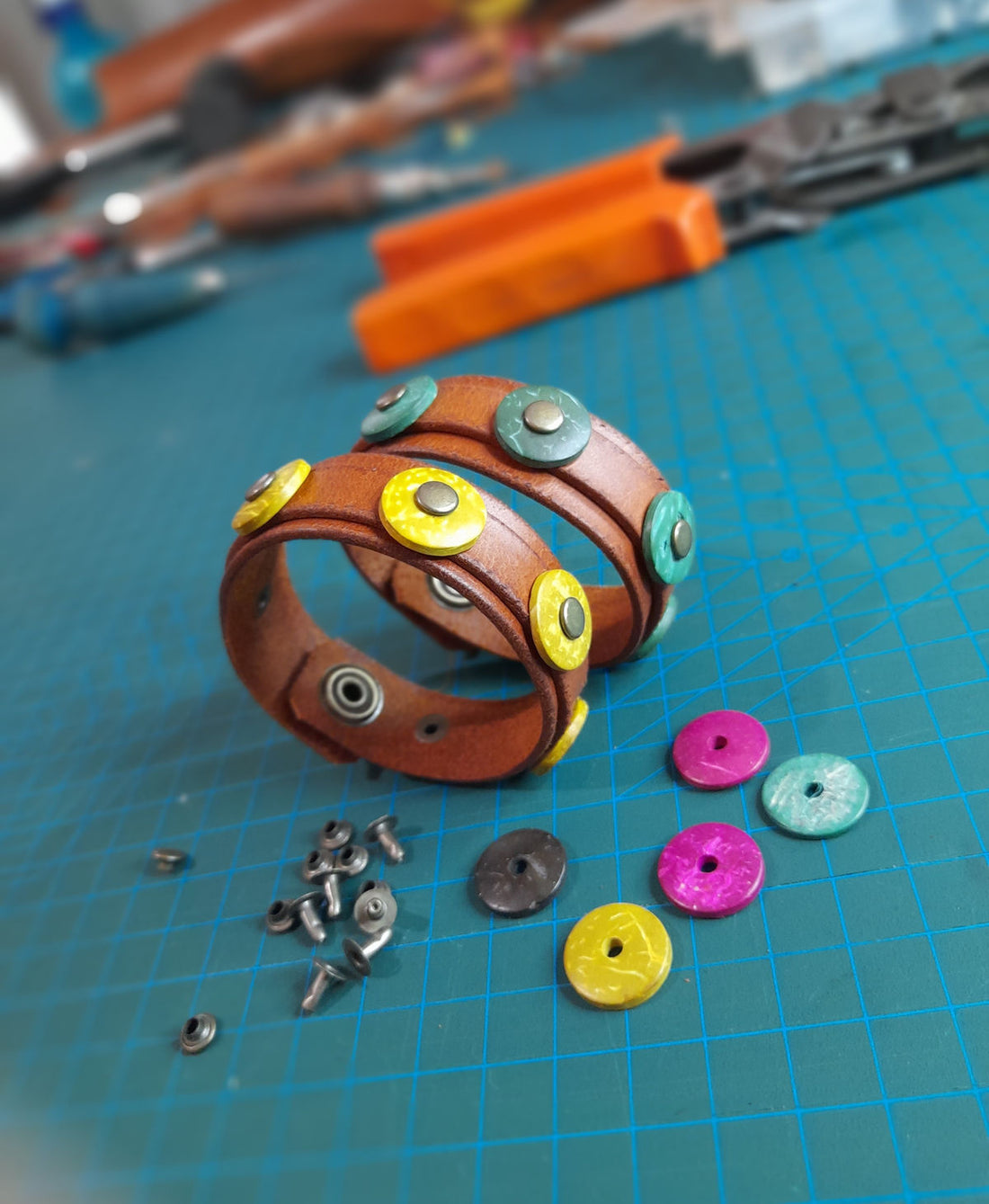
How to Tell If It's Truly Handmade (and If the Shop Is Real)
Simple, powerful ways to see what’s true — even if you’ve never bought handmade before.
There’s something deeply special about buying handmade.
It’s not just about the item, but the energy behind it: the care, the hours, the hands. An authentic handmade piece carries soul. A factory product doesn’t.
But how can you tell the difference?
Today’s online shops look and are beautiful and professional. They may even say the right words: "artisan-made," "unique," "crafted with love." But not all of them are telling the truth.
This simple handmade buyer’s guide will help you see through the surface and spot what’s real - without needing to be an expert.
1. Look for Imperfections (The Good Kind)
Handcrafted doesn’t mean flawless. It means human.
When something is truly handmade — stitched, carved, shaped, or braided by real hands, it will never be machine-perfect. You might see tiny quirks:
-
A stitch that's just slightly angled.
-
A small size variation between two “identical” pieces.
-
A flower that’s a little pinker than the one next to it.
These aren’t flaws. They’re proof. They’re the heartbeat in the work. And usually, they have a story hidden within their description. The inspiration behind it, the symbolism, the thought of the maker regarding "why" and "how" about it.

If everything looks exactly the same — sharp edges, factory precision — chances are it wasn’t made by hand.
And now you are probably wondering: "How should I know? I only want to buy one, not many - how will I compare them?"
This is a great question and the answer is in the shop's reviews. Many buyers take pictures of what they received: this is what you are looking for. For every single shop, some products sell better than others, and others are acting more as a "portfolio". Etsy is no different and the reviews sections are so rich, you will be able to find multiple reviews of the same "well selling" products with pictures, and you can compare them. Even if the specific product that you are interested in is not there, other products are.
And you'll start to see signs of whether it's real artisan work or a repeated mass-produced mold.
2. The Inventory Tells a Story (Or Raises a Red Flag)
If you're trying to figure out how to identify real handmade products, look at the shop as a whole. Real artists specialize. They may branch out, but their shop has a center of gravity.
Imagine a ceramic artist. Their shop might feature mugs, bowls, maybe a few wall tiles, but you’ll notice and feel the focus. Maybe 200 mugs, 50-60 other pieces. That’s consistency.
Check out my own shop - here or everywhere else you might find me. Yes, you will find some leather keychains, a few bookmarks, a couple of lanyards or bag charms. But you’ll also notice what everything revolves around: leather bracelets. That’s the craft I’ve deepened over time.

So if you see a shop that sells…
-
crochet blankets,
-
ceramic mugs,
-
pillowcases,
-
baby shoes,
-
and kitchen cutlery...
…that’s not a handmade artist. That’s a catalog. We makers might be good at many things — but we’re not that good - nobody can truly specialize in everything and still create genuine handmade items with care and quality.
Real shops don’t look like a department store. They look like someone’s craft took root — and grew.
A leather shop might have a few simple cuffs listed along with their niche inventory, but you will clearly see that their expertise is leather bags. Or mens belts. You get my point.
3. Watch the Sales Volume vs. Time Open
If a shop is claiming to sell handmade goods made by one person, their sales volume should reflect that.
A small studio - and especially a single-person-business (as many claim to be) can’t ship thousands of pieces per month, not even hundreds. It’s just not possible.
Do the math.
If a shop has, say, 35,000+ sales, but was only opened 3 years ago, and claims everything is fully handmade by one person, just ask yourself: How?
Even with help, even as a tight family small business, real handmade takes time. Cutting, knotting, drying, stitching, painting - it’s not instant.
If you're learning how to tell if a shop is legit, this is one of the biggest giveaways. A high-volume, high-speed shop claiming 100% handmade with no production help is suspicious at best.
Huge volume of constant sales suggest automation, outsourcing, or just mass production.
No shame in that of course, but it’s not what they are claiming and it's not what you are searching for. Plus, if it's being sold as handmade, then it's misleading too.
4. Ask Questions. Then Read the Answers.
This is one of the most powerful tools you have as a buyer. Ask questions! Ask things like:
-
Can you make this in black instead of brown?
-
What kind of leather is this, and where does it come from?
-
How will this material age or wear over time?
-
Can you explain how the sizing works on wider vs. thinner cuffs?
- Does it matter if I take a shower while wearing it?
A true handmade seller knows these answers like the back of their hand.
They’ve worked with the same materials for years. They know how leather behaves, where the closures sit best, and how to adjust something for you, because even with a size chart, not every M sized wrist is the same with another. How colors react to temperatures, how fabric absorbs each dye and so on.
And you know what? We love your questions. I do! I wish people would come and ask things daily, ask everything, ask anything! Not because I'm proud to answer properly. That too, but it comes second. The main reason is because your questions give me new, fresh sets of eyes to look at my items every time, read their descriptions, see from a buyer's perspective what I offer, how do I present it, and improve it.
Yes, improve. I cannot tell you how many times I have reworked and slightly improved the same listing and every time it was after a review, or a genuine question.
Tiny, precious gems of potential improvements, hidden behind words.
Speaking of improving, I make mistakes too. Mostly hilarious fails to be honest:

No matter how hard I try and how consistently I work on my shop, sometimes all my items look the same to me - and worst of all? Sometimes I assume that people already know the answer because I know it already so well, that is my second skin.
So, ask questions! And if the answers are vague, evasive, or overly rehearsed, it's a red flag. It's a sign you're not talking to the maker at all.
5. Reviews Reveal More Than Stars
Don’t just skim the stars and focus on how many 5-stars this and that shop have. A majority of 5-star ratings is not the whole image and it doesn't prove anything apart from okay, a real shop that for real ships something out. If you're wondering how to verify handmade sellers, reviews are a goldmine. Read the reviews. You’re not looking for perfection. You’re looking for realness.
✨ Do people talk about the packaging, the personal touches, the communication?
✨ Are there reviews with photos showing the item in real life?
✨ When something went wrong, how did the shop respond?
✨ Are the reviews way too similar, robotic and/or oddly short? ("Great! Love it! Fast shipping!") — that’s a red flag.
Good reviews are stories, not scorecards.
They tell you who the maker is, what they value, and how they treat people — long after the sale.
6. Read the Shop Story (If There Is One)
Real makers always have a story.
It may be short. It may be poetic. It might make no sense to you or others. But it exists.
They’ll tell you:
-
Why they make what they make.
-
How they started.
-
What their materials mean to them.
-
Why it matters.
If all you see is corporate filler — "Elevate your lifestyle with our premium craftsmanship!" and "Step in the realm of" — that’s not a story. That’s a placeholder.
Real handmade sellers don’t pitch. They speak. They show. They invite. Their story might not be perfect, and heck, it might even not make sense to anyone else, but it’s theirs.
Bonus Tip: Trust Your Gut
This may be the simplest and most important one of all.
When you look at a product or shop, take a deep breath and genuinely ask yourself:
Do I feel something here?
Does it feel warm, real, alive — like there’s a person on the other side of the screen? Or does it feel like a polished ad trying to win a click? Is there anything that feels off? Is everything just so... perfect?
Most of us are more intuitive than we think.
You don’t need to be an expert in handmade vs mass produced. Your intuition already knows. You just need to slow down, look closer, and ask the questions no machine can answer. Even AI can't answer properly. Yes, you will get an aswer, generally correct, generally relevant, not specifically relevant to you and the product you are interesting into buying.
No one else will tell you if the beeswaxed cord on that wallet smells like beeswax or plastic from the dye. Only the real maker can. And they will tell you truth, because once you have that wallet in your hands, you will smell it too (and write about it in your review, ha!)
Final Thought: Handmade Isn’t About “Perfect” — It’s About Real

There’s nothing wrong with mass-produced things. They have their place. But they don’t carry soul.
A truly handmade item is more than a just another product.
It’s a piece of someone’s time, energy, personal story, and spirit, a quiet echo of the hands that made it.
When you find that kind of work…
…you’ll feel it.
And you’ll never want to go back to mass produced crap (sorry!) Your hard-earned money will be fully justified with the purchase. And you will own something unique, to cherish it for many years to come.
